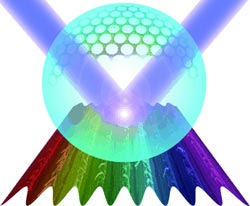

Butterfly wings, rose petals and many other natural surfaces repell water strongly; they are superhydrophobic.
Such surfaces have a hierarchical structure on the micrometer or nanometer scale. Their attractive properties and spectacular iridescent colors have triggered a group led by Hong-Bo Sun of Jilin University to prepare a superhydrophobic graphene surface with properties comparable to its natural counterparts. They report their findings in Chemistry – An Asian Journal.
The team from Changchun, China, split a 355 nm laser beam into two branches and guided them to interfere directly on the surface of a graphene oxide film. This method fabricates a periodic microscale grating structure while simultaneously removing the oxygen from the graphene oxide film.
The resulting superhydrophobic film showed colorful iridescence and unique high adhesion. Water droplets were repelled to show contact angles of up to almost 160° depending on laser power.
“Such surfaces could be used for applications in water transport and microfluidic devices,” says Sun, who demonstrated how the wettability of graphene can be controlled.
Author: Hong-Bo Sun, Jilin University, Changchun (China), http://www.lasun-jlu.cn/people.php
Title: Biomimetic Graphene Surfaces with Superhydrophobicity and Iridescence
Chemistry – An Asian Journal, Permalink to the article: http://dx.doi.org/10.1002/asia.201100882












